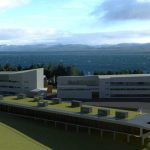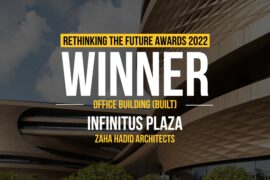This is a new Deep Ocean Research Base of a university campus in Shenzhen, China. Courtyard typologies in traditional campus are reinterpreted in this building vertically. The Research Base is actually made up of independent research centers which are stacked up vertically, with a floor of shared public facilities injected in between each two centers. Within each center, the volumes for research labs and the offices are pulled apart slightly to create vertical public spaces, which in turn connect the three public floors together, forming a series of continuous and dynamic social spaces filled with vegetation through the building, extending the gardens on the ground all the way up to the roof terrace.
Second Award | RTFA 2014 Awards
Category: Institutional Concept
Participant Name: Open Architecture
Country: China

The building is not unlike a vertical campus made up by small building blocks, and the shared open spaces in between not only ensure each center’s autonomy, but also provide abundant spaces for researchers to interact and socialize.

The form of the building was largely informed by the weather and natural condition of Shenzhen. Ample semi exterior spaces help to regulate the microclimate of the building; the thin slab tower takes full advantage of natural ventilation; façade shading system effectively cut out the heat gain while regulates natural light based on internal functions. The adoption of passive energy saving strategies is aiming to create a building that is both economical and energy efficient.

The planning of the lab spaces follows an optimized lab module. The layout is open yet sub dividable. MEP system also follows the lab module, allowing maximum flexibility to adapt to future changes.

The lower part of the building merges with the natural landscape of the surround campus, while hosting some facilities that will be open to the whole university, including exhibition spaces, meeting rooms, cafes and so on. This building will not only be a new type of research lab, but also a dynamic social energizer on the end of the grand axis of the campus.
Prev Post
University Campus | IDOM UK LTD
3 Mins Read

Next Post
UNRN Campus | Paulo Gaston Flores Arquitecto
3 Mins Read






